MA617 Forensic Accounting: A Detailed AIG Fraud Case Report
VerifiedAdded on 2023/06/08
|11
|2769
|399
Report
AI Summary
This report provides a comprehensive analysis of the AIG fraud case, focusing on the accounting manipulations and fraudulent activities within the company. It examines the background of AIG, the perpetration of the fraud scheme, and the methods used to conceal financial losses. The report details the detection of the fraud, the subsequent investigation, and the significant fallout, including financial losses and reputational damage. It also explores the lessons learned from the AIG case, offering recommendations for preventing similar occurrences in the future through improved regulatory oversight and ethical guidelines. The analysis covers various aspects, including improper intercompany transactions, misleading accounting practices, and the impact on the company's long-term growth, credibility, and goodwill.
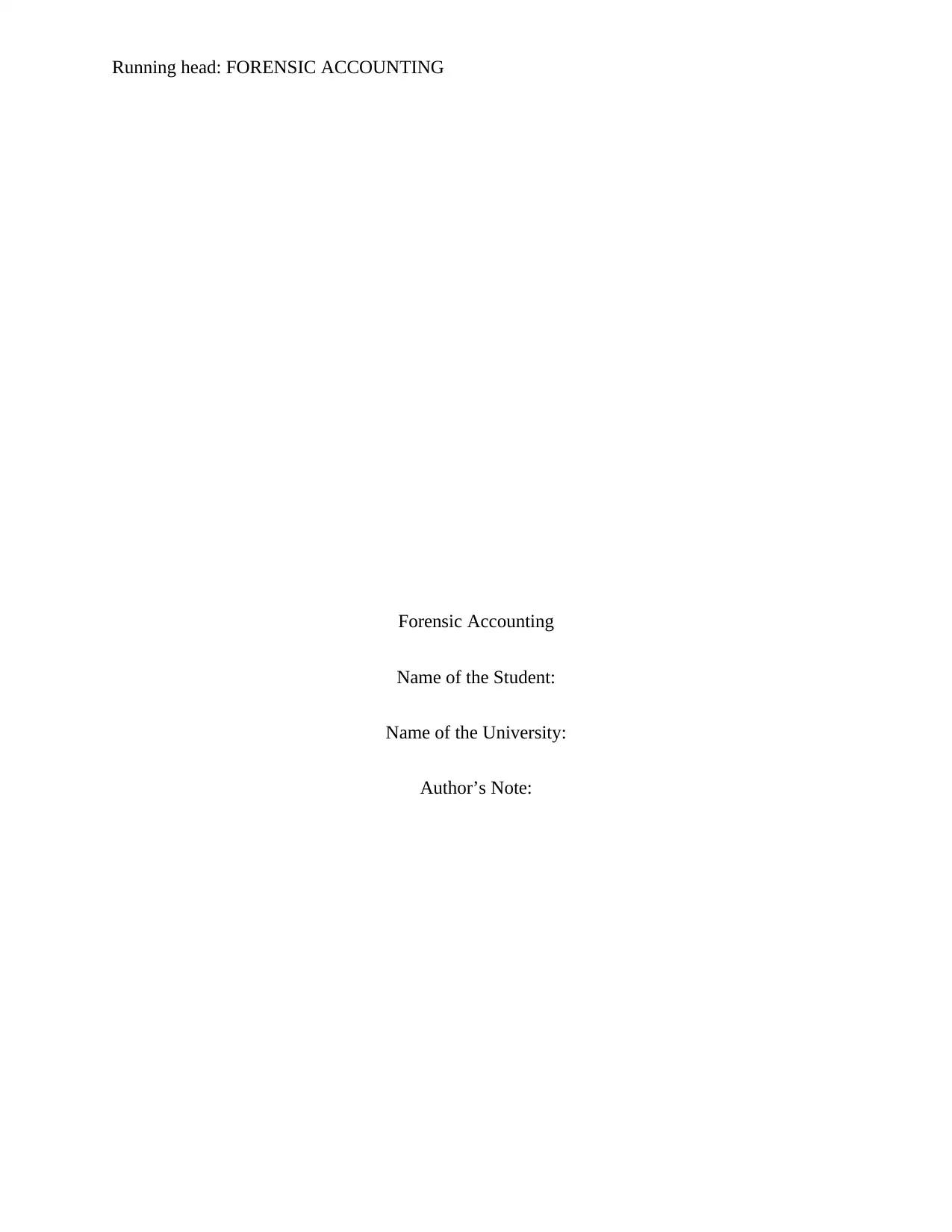
Running head: FORENSIC ACCOUNTING
Forensic Accounting
Name of the Student:
Name of the University:
Author’s Note:
Forensic Accounting
Name of the Student:
Name of the University:
Author’s Note:
Paraphrase This Document
Need a fresh take? Get an instant paraphrase of this document with our AI Paraphraser
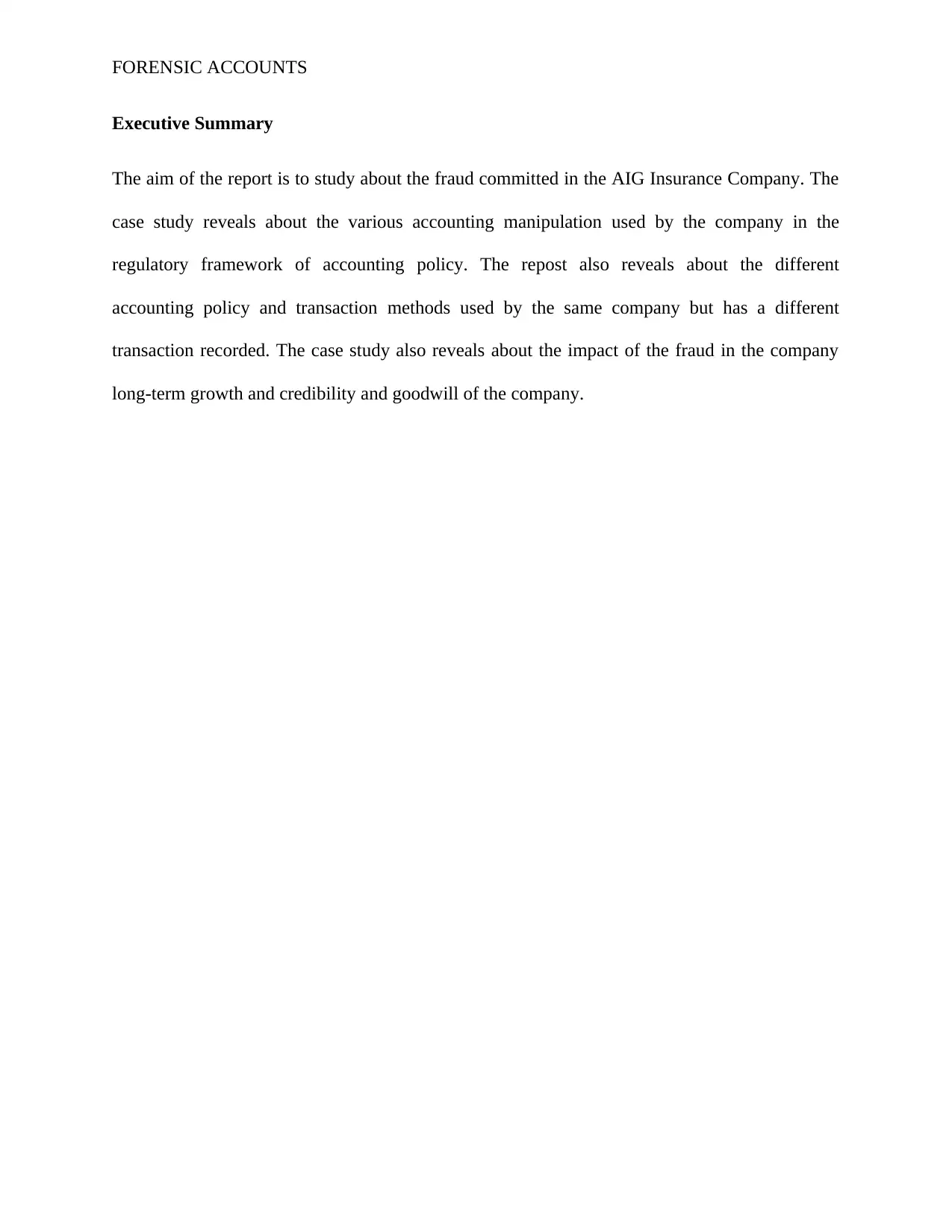
FORENSIC ACCOUNTS
Executive Summary
The aim of the report is to study about the fraud committed in the AIG Insurance Company. The
case study reveals about the various accounting manipulation used by the company in the
regulatory framework of accounting policy. The repost also reveals about the different
accounting policy and transaction methods used by the same company but has a different
transaction recorded. The case study also reveals about the impact of the fraud in the company
long-term growth and credibility and goodwill of the company.
Executive Summary
The aim of the report is to study about the fraud committed in the AIG Insurance Company. The
case study reveals about the various accounting manipulation used by the company in the
regulatory framework of accounting policy. The repost also reveals about the different
accounting policy and transaction methods used by the same company but has a different
transaction recorded. The case study also reveals about the impact of the fraud in the company
long-term growth and credibility and goodwill of the company.

FORENSIC ACCOUNTS
Table of Contents
Introduction......................................................................................................................................4
Discussion........................................................................................................................................5
Background..................................................................................................................................5
Perpetration of the AIG Fraud Scheme.......................................................................................5
Detection of Fraud Scheme.........................................................................................................6
The Investigation and the fallout.................................................................................................6
The Impact of Fallout..................................................................................................................8
Lessons Learned..........................................................................................................................9
Recommendations for Preventing Future Occurrence.................................................................9
Conclusion.....................................................................................................................................10
References......................................................................................................................................11
Table of Contents
Introduction......................................................................................................................................4
Discussion........................................................................................................................................5
Background..................................................................................................................................5
Perpetration of the AIG Fraud Scheme.......................................................................................5
Detection of Fraud Scheme.........................................................................................................6
The Investigation and the fallout.................................................................................................6
The Impact of Fallout..................................................................................................................8
Lessons Learned..........................................................................................................................9
Recommendations for Preventing Future Occurrence.................................................................9
Conclusion.....................................................................................................................................10
References......................................................................................................................................11
⊘ This is a preview!⊘
Do you want full access?
Subscribe today to unlock all pages.

Trusted by 1+ million students worldwide
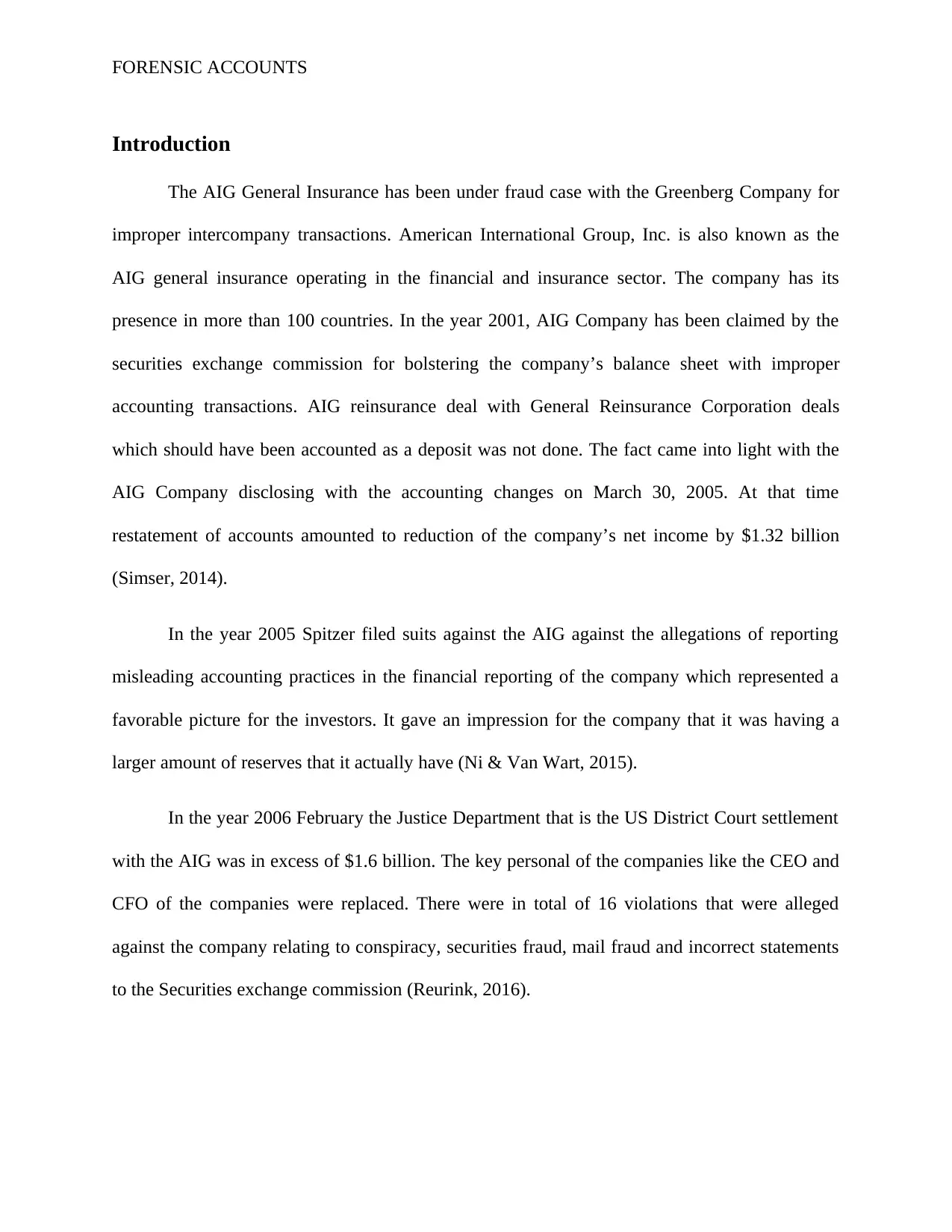
FORENSIC ACCOUNTS
Introduction
The AIG General Insurance has been under fraud case with the Greenberg Company for
improper intercompany transactions. American International Group, Inc. is also known as the
AIG general insurance operating in the financial and insurance sector. The company has its
presence in more than 100 countries. In the year 2001, AIG Company has been claimed by the
securities exchange commission for bolstering the company’s balance sheet with improper
accounting transactions. AIG reinsurance deal with General Reinsurance Corporation deals
which should have been accounted as a deposit was not done. The fact came into light with the
AIG Company disclosing with the accounting changes on March 30, 2005. At that time
restatement of accounts amounted to reduction of the company’s net income by $1.32 billion
(Simser, 2014).
In the year 2005 Spitzer filed suits against the AIG against the allegations of reporting
misleading accounting practices in the financial reporting of the company which represented a
favorable picture for the investors. It gave an impression for the company that it was having a
larger amount of reserves that it actually have (Ni & Van Wart, 2015).
In the year 2006 February the Justice Department that is the US District Court settlement
with the AIG was in excess of $1.6 billion. The key personal of the companies like the CEO and
CFO of the companies were replaced. There were in total of 16 violations that were alleged
against the company relating to conspiracy, securities fraud, mail fraud and incorrect statements
to the Securities exchange commission (Reurink, 2016).
Introduction
The AIG General Insurance has been under fraud case with the Greenberg Company for
improper intercompany transactions. American International Group, Inc. is also known as the
AIG general insurance operating in the financial and insurance sector. The company has its
presence in more than 100 countries. In the year 2001, AIG Company has been claimed by the
securities exchange commission for bolstering the company’s balance sheet with improper
accounting transactions. AIG reinsurance deal with General Reinsurance Corporation deals
which should have been accounted as a deposit was not done. The fact came into light with the
AIG Company disclosing with the accounting changes on March 30, 2005. At that time
restatement of accounts amounted to reduction of the company’s net income by $1.32 billion
(Simser, 2014).
In the year 2005 Spitzer filed suits against the AIG against the allegations of reporting
misleading accounting practices in the financial reporting of the company which represented a
favorable picture for the investors. It gave an impression for the company that it was having a
larger amount of reserves that it actually have (Ni & Van Wart, 2015).
In the year 2006 February the Justice Department that is the US District Court settlement
with the AIG was in excess of $1.6 billion. The key personal of the companies like the CEO and
CFO of the companies were replaced. There were in total of 16 violations that were alleged
against the company relating to conspiracy, securities fraud, mail fraud and incorrect statements
to the Securities exchange commission (Reurink, 2016).
Paraphrase This Document
Need a fresh take? Get an instant paraphrase of this document with our AI Paraphraser

FORENSIC ACCOUNTS
Discussion
Background
AIG is the leading company in the global leading insurance companies. The AIG
Company was alleged with a violation, which were treated as a criminal conduct under cases like
securities fraud and accounting manipulation. In the year 2000 October 26, the AIG Company
announced that the premiums it received for the insurance has increased steadily in the third
quarter of the financial year. At the same time the company said with the increase in premium
there was a substantial fall in the reserves of the company. The same was not treated to be in the
best interest of the investors and stakeholders of the company where the share price of the
company has seen a massive decrease by about 6%. The company was also charged with the fact
that it was using collateral for buying mortgage backed securities. It was also acquiesced of the
fact that the company was hiding financial losses in the company’s financial statements (Clarke
& Dean, 2014).
Perpetration of the AIG Fraud Scheme
Greenburg asked Ferguson for a temporary transfer of loss reserves to the AIG subjecting
an amount which is equal to around $200 to $500 million which will be with the AIG Company
for around 6-9 months of time frame. AIG had certain terms and conditions like it should not
suffer any loss or additional exposures. In contrast to the above deal General Reinsurance was
offered $5 million for going ahead with the deal (Khaneja, Bhargava & Gupta, 2017).
The round tripping of cash in which the CRD has paid $10 million in premium without
even paying for the same. The contract was an existing leverage one where the General
Reinsurance held $31.8 million which was payable to the AIG company. The General
Discussion
Background
AIG is the leading company in the global leading insurance companies. The AIG
Company was alleged with a violation, which were treated as a criminal conduct under cases like
securities fraud and accounting manipulation. In the year 2000 October 26, the AIG Company
announced that the premiums it received for the insurance has increased steadily in the third
quarter of the financial year. At the same time the company said with the increase in premium
there was a substantial fall in the reserves of the company. The same was not treated to be in the
best interest of the investors and stakeholders of the company where the share price of the
company has seen a massive decrease by about 6%. The company was also charged with the fact
that it was using collateral for buying mortgage backed securities. It was also acquiesced of the
fact that the company was hiding financial losses in the company’s financial statements (Clarke
& Dean, 2014).
Perpetration of the AIG Fraud Scheme
Greenburg asked Ferguson for a temporary transfer of loss reserves to the AIG subjecting
an amount which is equal to around $200 to $500 million which will be with the AIG Company
for around 6-9 months of time frame. AIG had certain terms and conditions like it should not
suffer any loss or additional exposures. In contrast to the above deal General Reinsurance was
offered $5 million for going ahead with the deal (Khaneja, Bhargava & Gupta, 2017).
The round tripping of cash in which the CRD has paid $10 million in premium without
even paying for the same. The contract was an existing leverage one where the General
Reinsurance held $31.8 million which was payable to the AIG company. The General
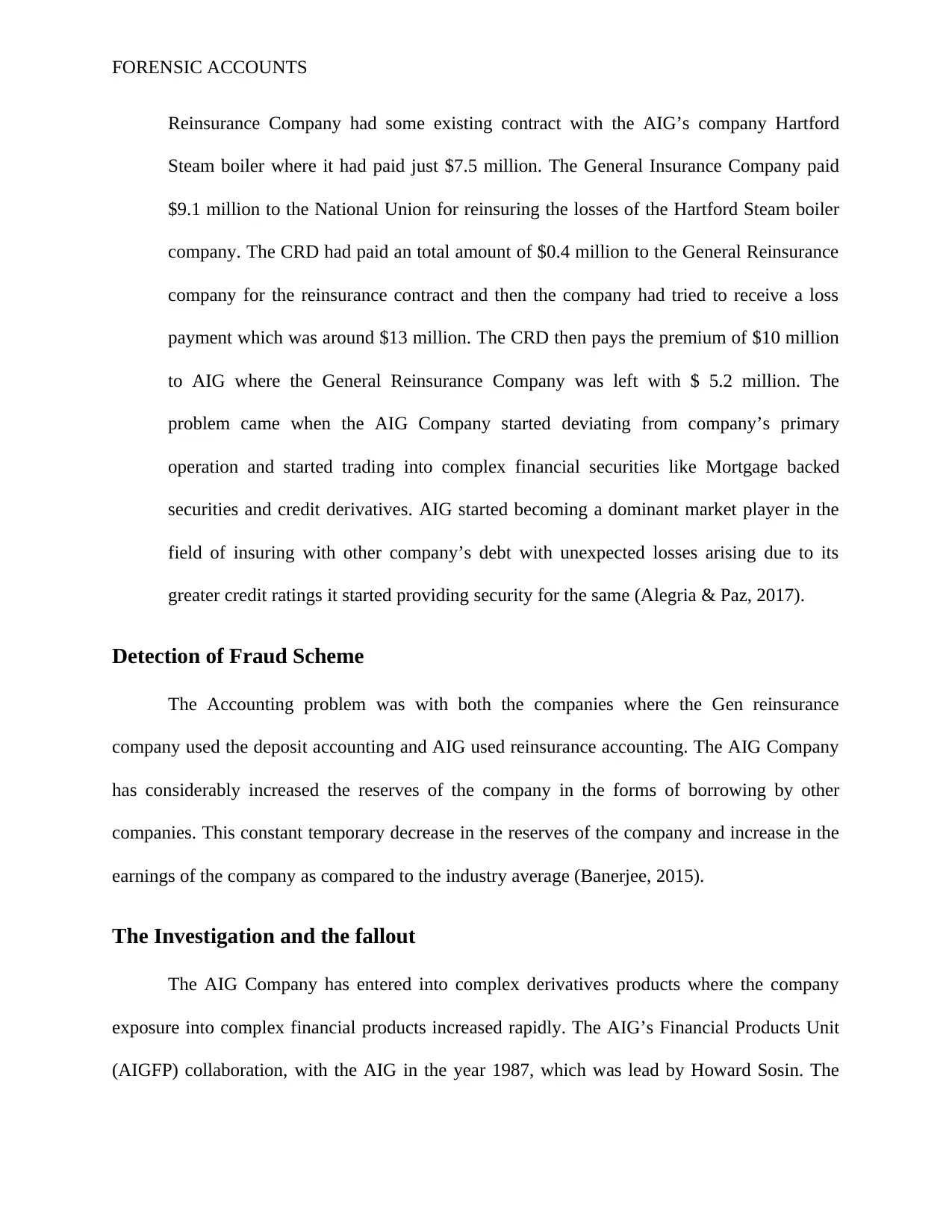
FORENSIC ACCOUNTS
Reinsurance Company had some existing contract with the AIG’s company Hartford
Steam boiler where it had paid just $7.5 million. The General Insurance Company paid
$9.1 million to the National Union for reinsuring the losses of the Hartford Steam boiler
company. The CRD had paid an total amount of $0.4 million to the General Reinsurance
company for the reinsurance contract and then the company had tried to receive a loss
payment which was around $13 million. The CRD then pays the premium of $10 million
to AIG where the General Reinsurance Company was left with $ 5.2 million. The
problem came when the AIG Company started deviating from company’s primary
operation and started trading into complex financial securities like Mortgage backed
securities and credit derivatives. AIG started becoming a dominant market player in the
field of insuring with other company’s debt with unexpected losses arising due to its
greater credit ratings it started providing security for the same (Alegria & Paz, 2017).
Detection of Fraud Scheme
The Accounting problem was with both the companies where the Gen reinsurance
company used the deposit accounting and AIG used reinsurance accounting. The AIG Company
has considerably increased the reserves of the company in the forms of borrowing by other
companies. This constant temporary decrease in the reserves of the company and increase in the
earnings of the company as compared to the industry average (Banerjee, 2015).
The Investigation and the fallout
The AIG Company has entered into complex derivatives products where the company
exposure into complex financial products increased rapidly. The AIG’s Financial Products Unit
(AIGFP) collaboration, with the AIG in the year 1987, which was lead by Howard Sosin. The
Reinsurance Company had some existing contract with the AIG’s company Hartford
Steam boiler where it had paid just $7.5 million. The General Insurance Company paid
$9.1 million to the National Union for reinsuring the losses of the Hartford Steam boiler
company. The CRD had paid an total amount of $0.4 million to the General Reinsurance
company for the reinsurance contract and then the company had tried to receive a loss
payment which was around $13 million. The CRD then pays the premium of $10 million
to AIG where the General Reinsurance Company was left with $ 5.2 million. The
problem came when the AIG Company started deviating from company’s primary
operation and started trading into complex financial securities like Mortgage backed
securities and credit derivatives. AIG started becoming a dominant market player in the
field of insuring with other company’s debt with unexpected losses arising due to its
greater credit ratings it started providing security for the same (Alegria & Paz, 2017).
Detection of Fraud Scheme
The Accounting problem was with both the companies where the Gen reinsurance
company used the deposit accounting and AIG used reinsurance accounting. The AIG Company
has considerably increased the reserves of the company in the forms of borrowing by other
companies. This constant temporary decrease in the reserves of the company and increase in the
earnings of the company as compared to the industry average (Banerjee, 2015).
The Investigation and the fallout
The AIG Company has entered into complex derivatives products where the company
exposure into complex financial products increased rapidly. The AIG’s Financial Products Unit
(AIGFP) collaboration, with the AIG in the year 1987, which was lead by Howard Sosin. The
⊘ This is a preview!⊘
Do you want full access?
Subscribe today to unlock all pages.

Trusted by 1+ million students worldwide
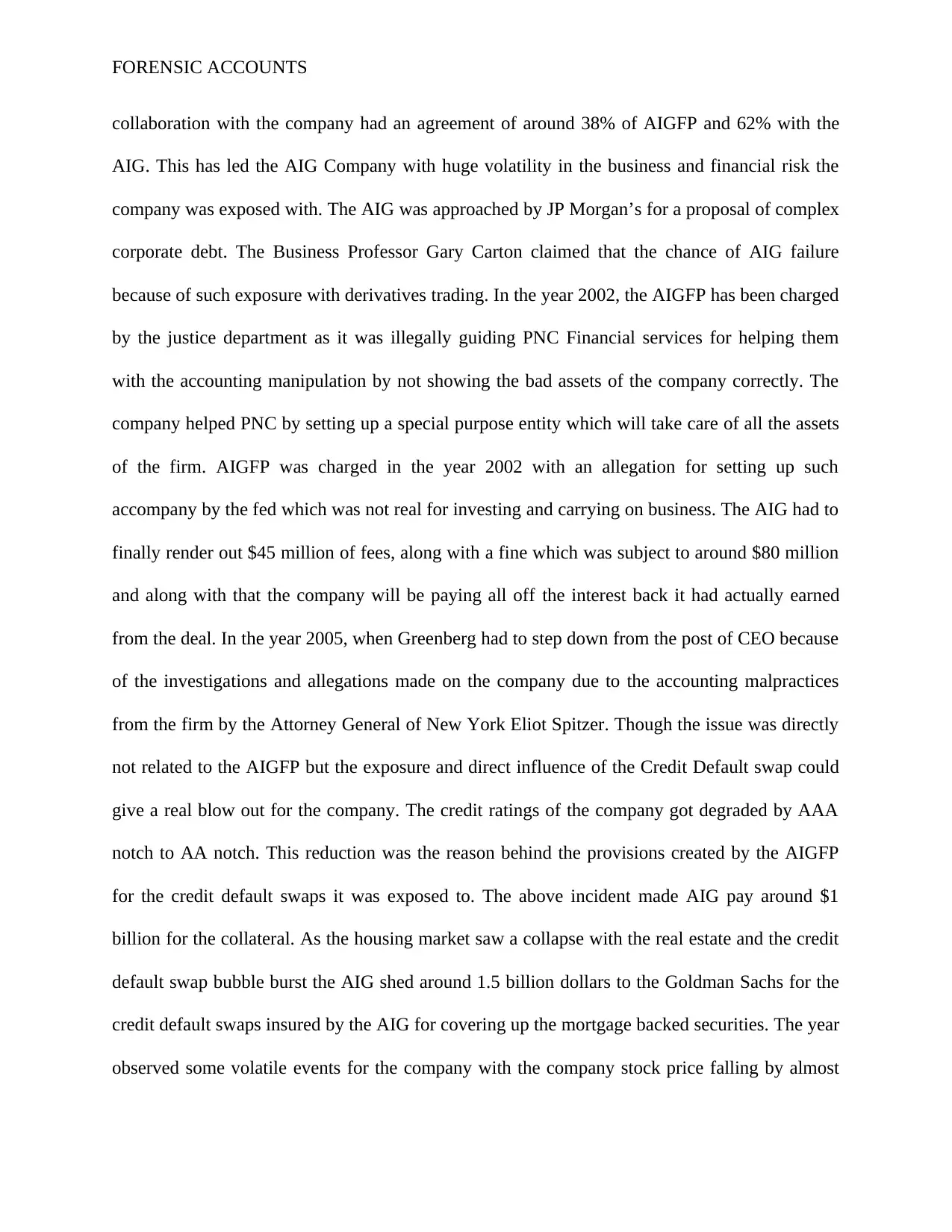
FORENSIC ACCOUNTS
collaboration with the company had an agreement of around 38% of AIGFP and 62% with the
AIG. This has led the AIG Company with huge volatility in the business and financial risk the
company was exposed with. The AIG was approached by JP Morgan’s for a proposal of complex
corporate debt. The Business Professor Gary Carton claimed that the chance of AIG failure
because of such exposure with derivatives trading. In the year 2002, the AIGFP has been charged
by the justice department as it was illegally guiding PNC Financial services for helping them
with the accounting manipulation by not showing the bad assets of the company correctly. The
company helped PNC by setting up a special purpose entity which will take care of all the assets
of the firm. AIGFP was charged in the year 2002 with an allegation for setting up such
accompany by the fed which was not real for investing and carrying on business. The AIG had to
finally render out $45 million of fees, along with a fine which was subject to around $80 million
and along with that the company will be paying all off the interest back it had actually earned
from the deal. In the year 2005, when Greenberg had to step down from the post of CEO because
of the investigations and allegations made on the company due to the accounting malpractices
from the firm by the Attorney General of New York Eliot Spitzer. Though the issue was directly
not related to the AIGFP but the exposure and direct influence of the Credit Default swap could
give a real blow out for the company. The credit ratings of the company got degraded by AAA
notch to AA notch. This reduction was the reason behind the provisions created by the AIGFP
for the credit default swaps it was exposed to. The above incident made AIG pay around $1
billion for the collateral. As the housing market saw a collapse with the real estate and the credit
default swap bubble burst the AIG shed around 1.5 billion dollars to the Goldman Sachs for the
credit default swaps insured by the AIG for covering up the mortgage backed securities. The year
observed some volatile events for the company with the company stock price falling by almost
collaboration with the company had an agreement of around 38% of AIGFP and 62% with the
AIG. This has led the AIG Company with huge volatility in the business and financial risk the
company was exposed with. The AIG was approached by JP Morgan’s for a proposal of complex
corporate debt. The Business Professor Gary Carton claimed that the chance of AIG failure
because of such exposure with derivatives trading. In the year 2002, the AIGFP has been charged
by the justice department as it was illegally guiding PNC Financial services for helping them
with the accounting manipulation by not showing the bad assets of the company correctly. The
company helped PNC by setting up a special purpose entity which will take care of all the assets
of the firm. AIGFP was charged in the year 2002 with an allegation for setting up such
accompany by the fed which was not real for investing and carrying on business. The AIG had to
finally render out $45 million of fees, along with a fine which was subject to around $80 million
and along with that the company will be paying all off the interest back it had actually earned
from the deal. In the year 2005, when Greenberg had to step down from the post of CEO because
of the investigations and allegations made on the company due to the accounting malpractices
from the firm by the Attorney General of New York Eliot Spitzer. Though the issue was directly
not related to the AIGFP but the exposure and direct influence of the Credit Default swap could
give a real blow out for the company. The credit ratings of the company got degraded by AAA
notch to AA notch. This reduction was the reason behind the provisions created by the AIGFP
for the credit default swaps it was exposed to. The above incident made AIG pay around $1
billion for the collateral. As the housing market saw a collapse with the real estate and the credit
default swap bubble burst the AIG shed around 1.5 billion dollars to the Goldman Sachs for the
credit default swaps insured by the AIG for covering up the mortgage backed securities. The year
observed some volatile events for the company with the company stock price falling by almost
Paraphrase This Document
Need a fresh take? Get an instant paraphrase of this document with our AI Paraphraser
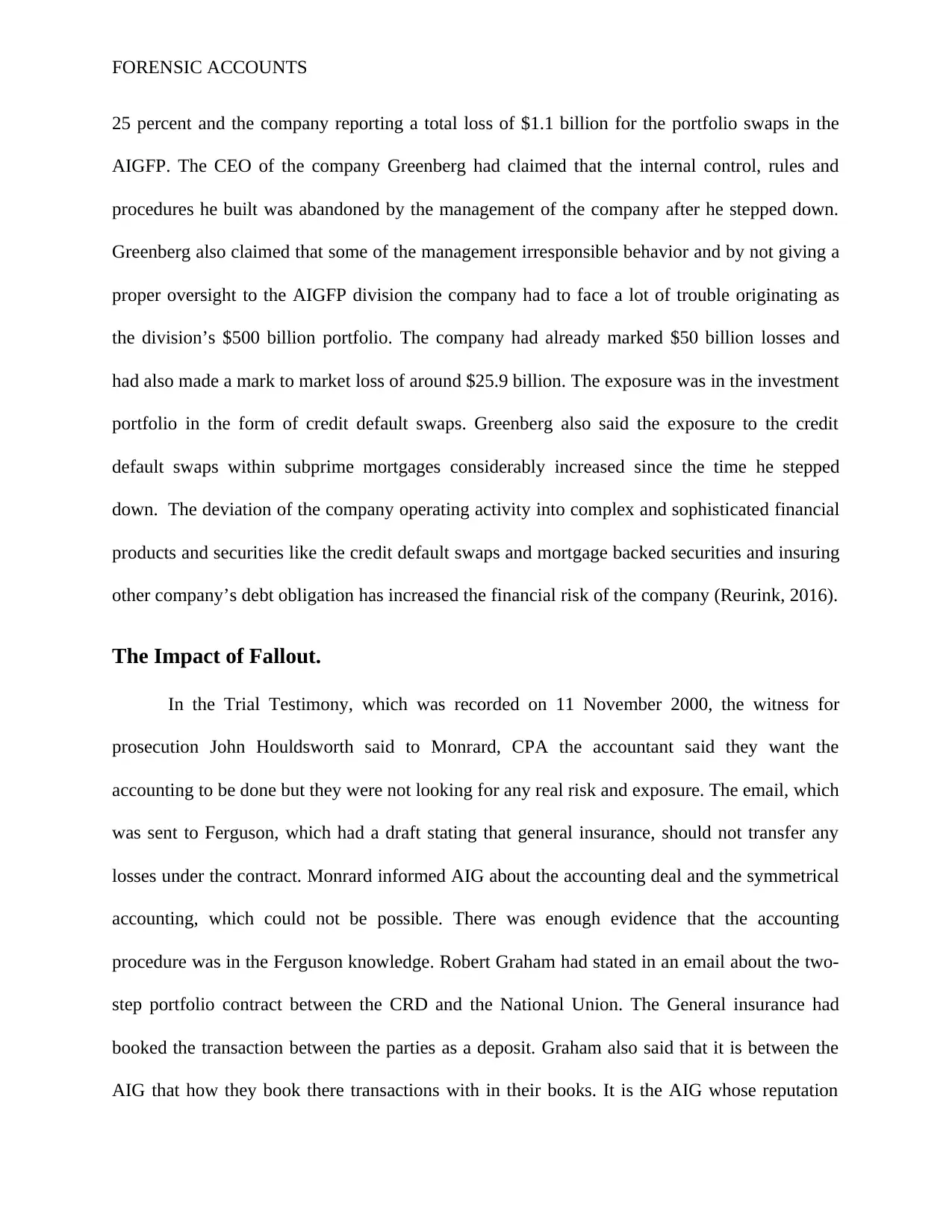
FORENSIC ACCOUNTS
25 percent and the company reporting a total loss of $1.1 billion for the portfolio swaps in the
AIGFP. The CEO of the company Greenberg had claimed that the internal control, rules and
procedures he built was abandoned by the management of the company after he stepped down.
Greenberg also claimed that some of the management irresponsible behavior and by not giving a
proper oversight to the AIGFP division the company had to face a lot of trouble originating as
the division’s $500 billion portfolio. The company had already marked $50 billion losses and
had also made a mark to market loss of around $25.9 billion. The exposure was in the investment
portfolio in the form of credit default swaps. Greenberg also said the exposure to the credit
default swaps within subprime mortgages considerably increased since the time he stepped
down. The deviation of the company operating activity into complex and sophisticated financial
products and securities like the credit default swaps and mortgage backed securities and insuring
other company’s debt obligation has increased the financial risk of the company (Reurink, 2016).
The Impact of Fallout.
In the Trial Testimony, which was recorded on 11 November 2000, the witness for
prosecution John Houldsworth said to Monrard, CPA the accountant said they want the
accounting to be done but they were not looking for any real risk and exposure. The email, which
was sent to Ferguson, which had a draft stating that general insurance, should not transfer any
losses under the contract. Monrard informed AIG about the accounting deal and the symmetrical
accounting, which could not be possible. There was enough evidence that the accounting
procedure was in the Ferguson knowledge. Robert Graham had stated in an email about the two-
step portfolio contract between the CRD and the National Union. The General insurance had
booked the transaction between the parties as a deposit. Graham also said that it is between the
AIG that how they book there transactions with in their books. It is the AIG whose reputation
25 percent and the company reporting a total loss of $1.1 billion for the portfolio swaps in the
AIGFP. The CEO of the company Greenberg had claimed that the internal control, rules and
procedures he built was abandoned by the management of the company after he stepped down.
Greenberg also claimed that some of the management irresponsible behavior and by not giving a
proper oversight to the AIGFP division the company had to face a lot of trouble originating as
the division’s $500 billion portfolio. The company had already marked $50 billion losses and
had also made a mark to market loss of around $25.9 billion. The exposure was in the investment
portfolio in the form of credit default swaps. Greenberg also said the exposure to the credit
default swaps within subprime mortgages considerably increased since the time he stepped
down. The deviation of the company operating activity into complex and sophisticated financial
products and securities like the credit default swaps and mortgage backed securities and insuring
other company’s debt obligation has increased the financial risk of the company (Reurink, 2016).
The Impact of Fallout.
In the Trial Testimony, which was recorded on 11 November 2000, the witness for
prosecution John Houldsworth said to Monrard, CPA the accountant said they want the
accounting to be done but they were not looking for any real risk and exposure. The email, which
was sent to Ferguson, which had a draft stating that general insurance, should not transfer any
losses under the contract. Monrard informed AIG about the accounting deal and the symmetrical
accounting, which could not be possible. There was enough evidence that the accounting
procedure was in the Ferguson knowledge. Robert Graham had stated in an email about the two-
step portfolio contract between the CRD and the National Union. The General insurance had
booked the transaction between the parties as a deposit. Graham also said that it is between the
AIG that how they book there transactions with in their books. It is the AIG whose reputation
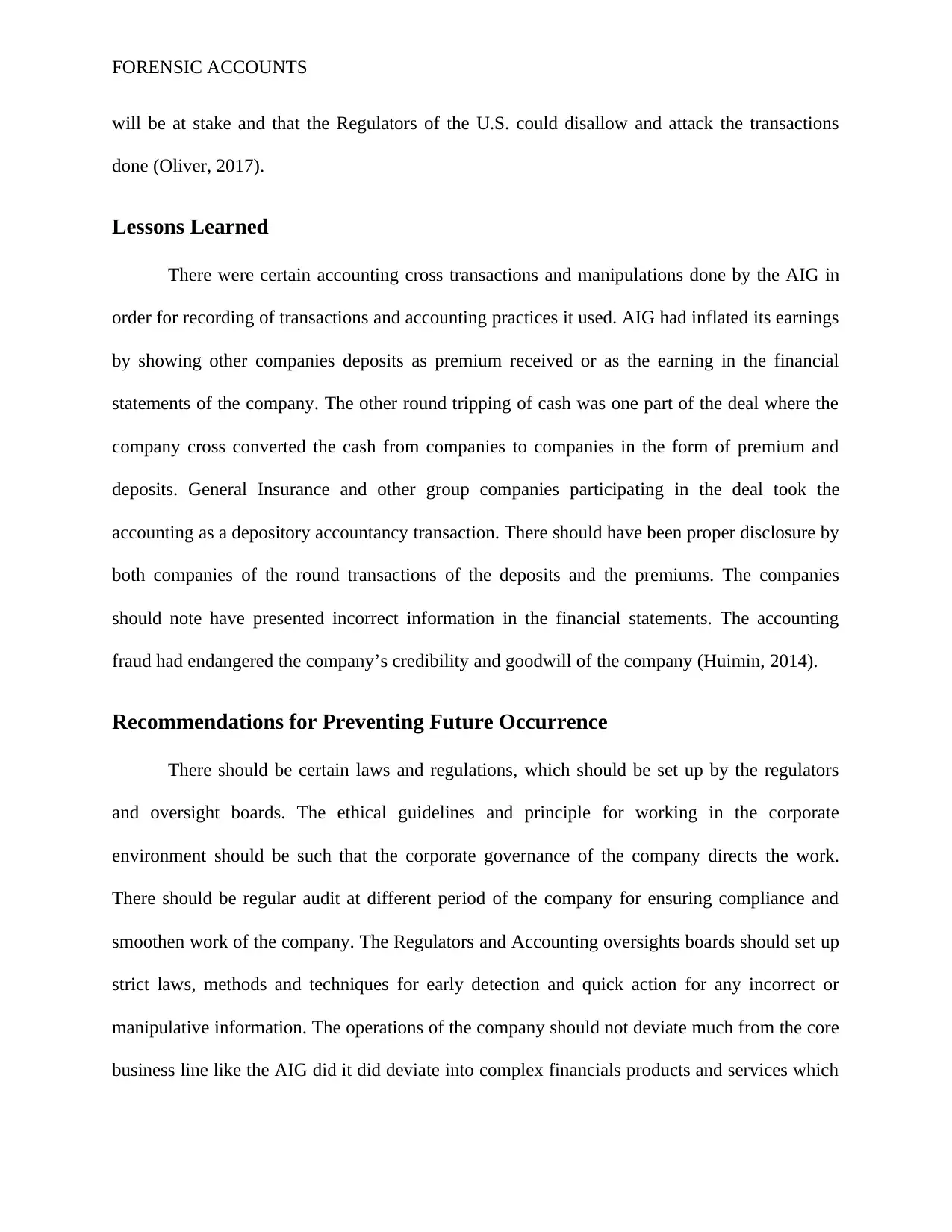
FORENSIC ACCOUNTS
will be at stake and that the Regulators of the U.S. could disallow and attack the transactions
done (Oliver, 2017).
Lessons Learned
There were certain accounting cross transactions and manipulations done by the AIG in
order for recording of transactions and accounting practices it used. AIG had inflated its earnings
by showing other companies deposits as premium received or as the earning in the financial
statements of the company. The other round tripping of cash was one part of the deal where the
company cross converted the cash from companies to companies in the form of premium and
deposits. General Insurance and other group companies participating in the deal took the
accounting as a depository accountancy transaction. There should have been proper disclosure by
both companies of the round transactions of the deposits and the premiums. The companies
should note have presented incorrect information in the financial statements. The accounting
fraud had endangered the company’s credibility and goodwill of the company (Huimin, 2014).
Recommendations for Preventing Future Occurrence
There should be certain laws and regulations, which should be set up by the regulators
and oversight boards. The ethical guidelines and principle for working in the corporate
environment should be such that the corporate governance of the company directs the work.
There should be regular audit at different period of the company for ensuring compliance and
smoothen work of the company. The Regulators and Accounting oversights boards should set up
strict laws, methods and techniques for early detection and quick action for any incorrect or
manipulative information. The operations of the company should not deviate much from the core
business line like the AIG did it did deviate into complex financials products and services which
will be at stake and that the Regulators of the U.S. could disallow and attack the transactions
done (Oliver, 2017).
Lessons Learned
There were certain accounting cross transactions and manipulations done by the AIG in
order for recording of transactions and accounting practices it used. AIG had inflated its earnings
by showing other companies deposits as premium received or as the earning in the financial
statements of the company. The other round tripping of cash was one part of the deal where the
company cross converted the cash from companies to companies in the form of premium and
deposits. General Insurance and other group companies participating in the deal took the
accounting as a depository accountancy transaction. There should have been proper disclosure by
both companies of the round transactions of the deposits and the premiums. The companies
should note have presented incorrect information in the financial statements. The accounting
fraud had endangered the company’s credibility and goodwill of the company (Huimin, 2014).
Recommendations for Preventing Future Occurrence
There should be certain laws and regulations, which should be set up by the regulators
and oversight boards. The ethical guidelines and principle for working in the corporate
environment should be such that the corporate governance of the company directs the work.
There should be regular audit at different period of the company for ensuring compliance and
smoothen work of the company. The Regulators and Accounting oversights boards should set up
strict laws, methods and techniques for early detection and quick action for any incorrect or
manipulative information. The operations of the company should not deviate much from the core
business line like the AIG did it did deviate into complex financials products and services which
⊘ This is a preview!⊘
Do you want full access?
Subscribe today to unlock all pages.

Trusted by 1+ million students worldwide
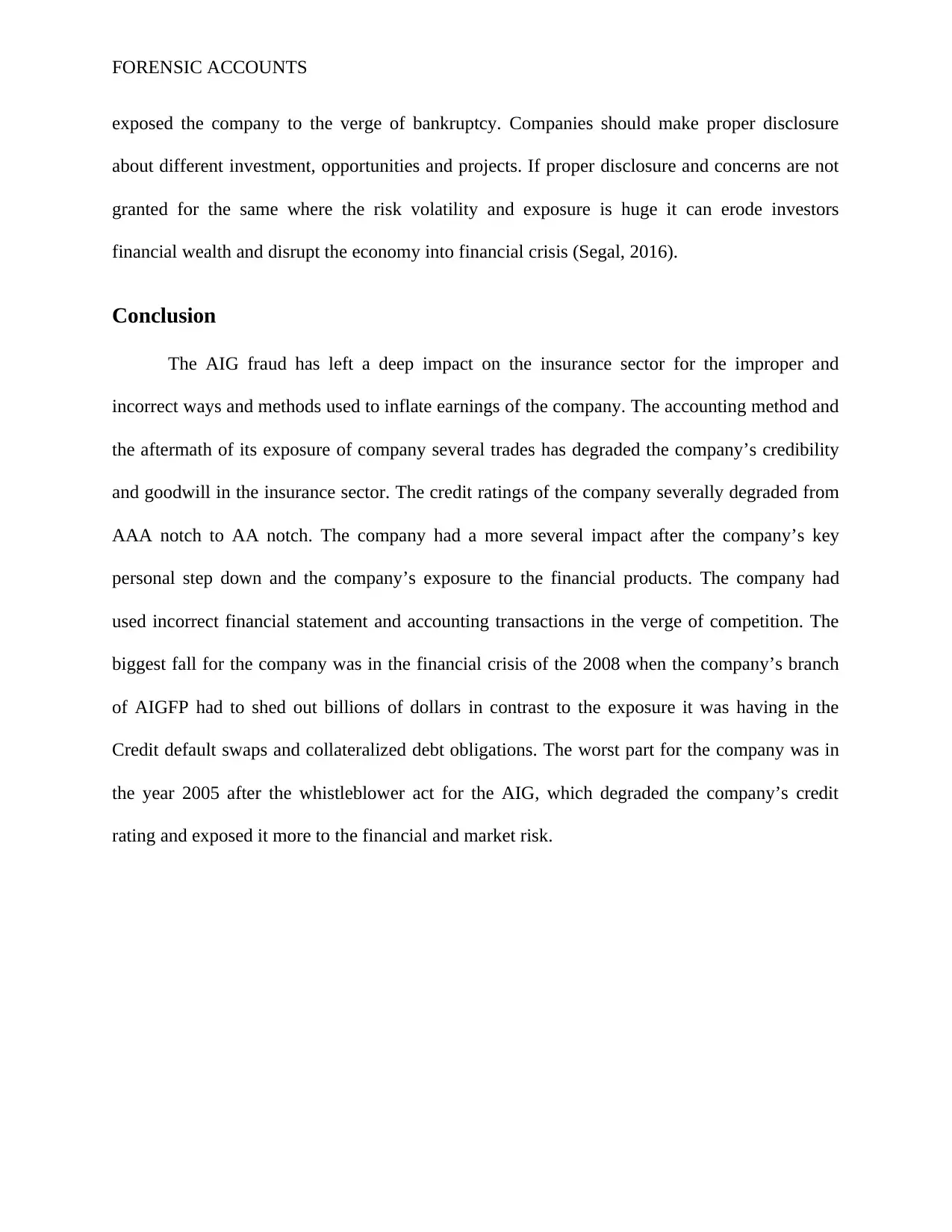
FORENSIC ACCOUNTS
exposed the company to the verge of bankruptcy. Companies should make proper disclosure
about different investment, opportunities and projects. If proper disclosure and concerns are not
granted for the same where the risk volatility and exposure is huge it can erode investors
financial wealth and disrupt the economy into financial crisis (Segal, 2016).
Conclusion
The AIG fraud has left a deep impact on the insurance sector for the improper and
incorrect ways and methods used to inflate earnings of the company. The accounting method and
the aftermath of its exposure of company several trades has degraded the company’s credibility
and goodwill in the insurance sector. The credit ratings of the company severally degraded from
AAA notch to AA notch. The company had a more several impact after the company’s key
personal step down and the company’s exposure to the financial products. The company had
used incorrect financial statement and accounting transactions in the verge of competition. The
biggest fall for the company was in the financial crisis of the 2008 when the company’s branch
of AIGFP had to shed out billions of dollars in contrast to the exposure it was having in the
Credit default swaps and collateralized debt obligations. The worst part for the company was in
the year 2005 after the whistleblower act for the AIG, which degraded the company’s credit
rating and exposed it more to the financial and market risk.
exposed the company to the verge of bankruptcy. Companies should make proper disclosure
about different investment, opportunities and projects. If proper disclosure and concerns are not
granted for the same where the risk volatility and exposure is huge it can erode investors
financial wealth and disrupt the economy into financial crisis (Segal, 2016).
Conclusion
The AIG fraud has left a deep impact on the insurance sector for the improper and
incorrect ways and methods used to inflate earnings of the company. The accounting method and
the aftermath of its exposure of company several trades has degraded the company’s credibility
and goodwill in the insurance sector. The credit ratings of the company severally degraded from
AAA notch to AA notch. The company had a more several impact after the company’s key
personal step down and the company’s exposure to the financial products. The company had
used incorrect financial statement and accounting transactions in the verge of competition. The
biggest fall for the company was in the financial crisis of the 2008 when the company’s branch
of AIGFP had to shed out billions of dollars in contrast to the exposure it was having in the
Credit default swaps and collateralized debt obligations. The worst part for the company was in
the year 2005 after the whistleblower act for the AIG, which degraded the company’s credit
rating and exposed it more to the financial and market risk.
Paraphrase This Document
Need a fresh take? Get an instant paraphrase of this document with our AI Paraphraser

FORENSIC ACCOUNTS
References
Alegria, J., & Paz, M. (2017). Fighting Accounting Fraud through Forensic Analytics.
Banerjee, R. (2015). Who Cheats and How?: Scams, Fraud and the Dark Side of the Corporate
World. SAGE Publications India.
Clarke, F., & Dean, G. (2014). Corporate Collapse: Regulatory, Accounting and Ethical Failure.
In Accounting and Regulation (pp. 9-29). Springer, New York, NY.
Huimin, M. (2014). FINAL PAPER.
Khaneja, S., Bhargava, V., & Gupta, L. (2017). Redefining the Role of Auditor in Curbing
Creative Accounting Practices. International Journal of Management and Social Sciences
Research (IJMSSR), 6(3), 32-37.
Ni, A., & Van Wart, M. (2015). Corporate Social Responsibility: Doing Well and Doing Good.
In Building Business-Government Relations (pp. 175-196). Routledge.
Oliver, J. (2017). Is “transgenerational response” a hidden cause of failed corporate turnarounds
and chronic underperformance?. Strategy & Leadership, 45(3), 23-29.
Reurink, A. (2016). Financial fraud: A literature review (No. 16/5). MPIfG Discussion Paper.
Reurink, A. (2016). Financial fraud: A literature review (No. 16/5). MPIfG Discussion Paper.
Segal, S. (2016). Accounting frauds–review of advanced technologies to detect and prevent
frauds. Economics and Business Review, 2(4), 45-64.
Simser, J. (2014). Culpable insiders–the enemy within, the victim without. Journal of Financial
Crime, 21(3), 310-320.
References
Alegria, J., & Paz, M. (2017). Fighting Accounting Fraud through Forensic Analytics.
Banerjee, R. (2015). Who Cheats and How?: Scams, Fraud and the Dark Side of the Corporate
World. SAGE Publications India.
Clarke, F., & Dean, G. (2014). Corporate Collapse: Regulatory, Accounting and Ethical Failure.
In Accounting and Regulation (pp. 9-29). Springer, New York, NY.
Huimin, M. (2014). FINAL PAPER.
Khaneja, S., Bhargava, V., & Gupta, L. (2017). Redefining the Role of Auditor in Curbing
Creative Accounting Practices. International Journal of Management and Social Sciences
Research (IJMSSR), 6(3), 32-37.
Ni, A., & Van Wart, M. (2015). Corporate Social Responsibility: Doing Well and Doing Good.
In Building Business-Government Relations (pp. 175-196). Routledge.
Oliver, J. (2017). Is “transgenerational response” a hidden cause of failed corporate turnarounds
and chronic underperformance?. Strategy & Leadership, 45(3), 23-29.
Reurink, A. (2016). Financial fraud: A literature review (No. 16/5). MPIfG Discussion Paper.
Reurink, A. (2016). Financial fraud: A literature review (No. 16/5). MPIfG Discussion Paper.
Segal, S. (2016). Accounting frauds–review of advanced technologies to detect and prevent
frauds. Economics and Business Review, 2(4), 45-64.
Simser, J. (2014). Culpable insiders–the enemy within, the victim without. Journal of Financial
Crime, 21(3), 310-320.
1 out of 11
Related Documents
Your All-in-One AI-Powered Toolkit for Academic Success.
+13062052269
info@desklib.com
Available 24*7 on WhatsApp / Email
![[object Object]](/_next/static/media/star-bottom.7253800d.svg)
Unlock your academic potential
Copyright © 2020–2025 A2Z Services. All Rights Reserved. Developed and managed by ZUCOL.



